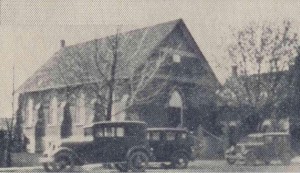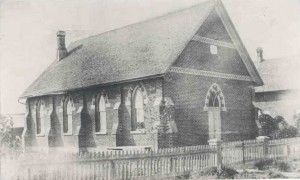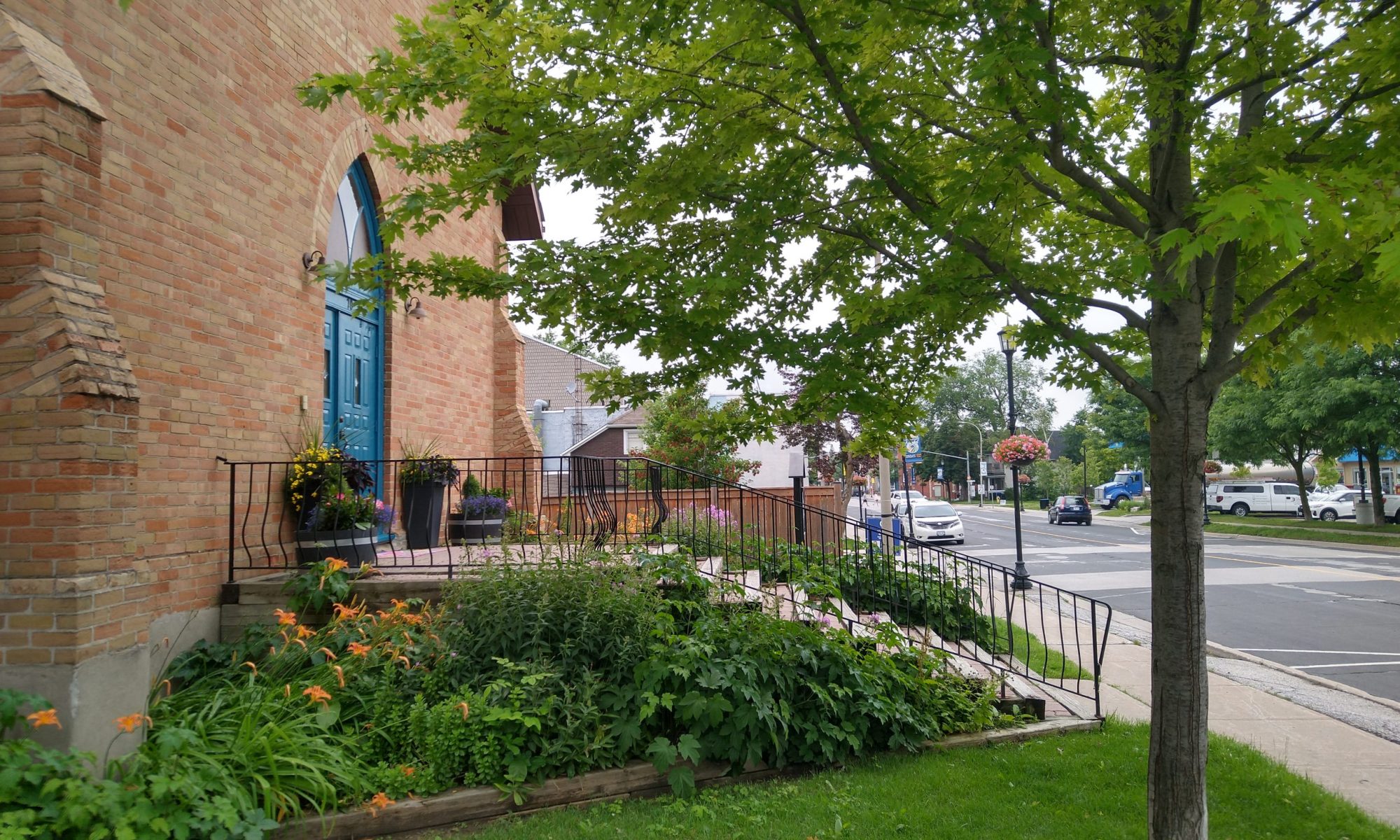
The History of Fraser Church, Tottenham
The Beginnings
Fraser Church began nearly 200 years ago when it wasn’t in Tottenham, and wasn’t called Fraser. Presbyterians from Ireland were among the earliest settlers of Tecumseth arriving in the 1820s. At the time, the nearest congregation they could join for worship was the meeting house at the Scotch settlement in West Gwillimbury. This was organized in 1821 by the Rev. William Jenkins who served the Synod of the Canadas (a Canadian Presbyterian denomination preceding the United Presbytery/Synod of Upper Canada). Rev. Jenkins traveled extensively in his ministry but only occasionally visited the small congregation. This continued until 1830 when the Rev. Peter Ferguson arrived from Scotland and was inducted to the charge by the United Presbytery in the spring of the following year. As the local population grew, the congregation was able to establish other meeting locations beyond West Gwillimbury, including the home of James Ellison in western Tecumseth.
The situation was looking promising for the Presbyterians in south Simcoe County until their new minister left in the spring of 1832 to serve another church in near Milton. The congregation then faced the challenge of finding a replacement. By this time there was a theological debate in Presbyterian circles concerning the relationship between the church and state. While many Presbyterians were beginning to adopt the voluntary principle which opposed government funding for church clergy, many others believed it was preferable. This debate divided the United Synod with the majority in favour of receiving government support, believing they were being treated unfairly by the Upper Canadian government for not receiving a share from the clergy reserves with the Church of Scotland Presbyterians. In the United Synod, Rev. Jenkins and Rev. James Harris of York supported the volutarist cause.
The division affected the South Simcoe congregation. The members living outside of West Gwillimbury were voluntarists, whereas the majority living in the Scotch Settlement were not. As a result, the West Gwillimbury group voted to find a minister from the grant-receiving Church of Scotland. The remaining congregants then held their own meeting and voted unanimously to remain within the United Synod of Upper Canada which did not receive government funds. Despite this formal division, the two congregations shared the use of the original meeting house in the Scotch Settlement.

The voluntarist congregation then proceeded to seek their own minister. On October 9 of the following year, James Howey of Ireland was ordained and inducted to the charge. His ministry was very short, however, has he had contracted tuberculosis and became too sick to complete his first worship service after his induction. The congregation carried on without a minister or support from the United Synod which had begun to seek a merger with the Church of Scotland. It would be more than a year before help would arrive through another Presbyterian body, the Missionary Presbytery of the United Secession Church of Scotland. This small band of missionaries had originally planned to work with the United Synod of Upper Canada, but learning of its plan to join the Church of Scotland, they decided to form their own presbytery adhering to the voluntary principle. They began establishing congregations mostly west of Toronto but sent the struggling Simcoe County congregation two Nova Scotian missionaries in turn. Being appreciative of the support and in accordance with Rev. Howey’s dying request, the congregation voted unanimously to join the Missionary Presbytery on March 27, 1835. Two months later they sent a letter to the second missionary requesting that he return to become their minister. Although this meant giving up his original mission of reaching Gaelic-speaking Scots, he accepted the invitation and began serving the congregation on August 9, 1835. He settled near Bond Head and donated land for a new church and cemetery (with the original church later being sold to the Church of Scotland congregation). He was officially inducted on June 17, 1836 and soon organized the Presbyterians in West Gwillimbury, Essa, and Tecumseth into three congregations, including the church near Tottenham. That minister was the Rev. William Fraser.
 The Place
The Place
Before a church was built in the Tottenham, worship was held at the home of James Ellison on the Second concession. But even after Rev. Fraser’s arrival, services took place there only once a month due to his other preaching responsibilities. After three new elders were ordained on July 12, 1836, the Presbyterians in Tecumseth could finally make decisions and function as a distinct congregation. The church transitioned from monthly to weekly worship and within four years grew from 5 to 28 members. An acre of land was purchased on the 3rd Concession, just northwest of the Ellison home, and by the early 1840s a log church had been built. By 1856 the congregation’s growth justified becoming independent of its sister churches and forming into a single point charge, although it was soon linked to the new church in Beeton. A new frame church was constructed around 1860, which served the congregation until the move in 1881 to the current brick church in Tottenham. By the 1930s the church was raised to create a downstairs hall. In 2001 the back end was extended to increase the sanctuary and create a nursery space downstairs. The newest addition, an accessible entrance and lift, was added on the south side in 2014. However, the main structure from 1881 still stands as one of the older church buildings in New Tecumseth.

The Name
In official records the congregation was simply referred to by its location, “Tecumseth”. This later became “1st Tecumseth” when a new congregation, “2nd Tecumseth” was started in Beeton in 1859. According to local history it was also called “Ellison’s Church” in the early days, after the congregation’s original host (pictured left). On November 24, 1885, the congregation was officially named “Fraser Church” in honour of the minister who had arrived 50 years earlier and organized an enduring congregation from the settlers who first gathered for worship at the Ellison home.
Former Ministers and Years of Service
1822-1830 Rev. William Jenkins
1830-1832 Rev. Peter Ferguson
1833-1835 Rev. James Howey
1835-1856 Rev. William Fraser
1858-1862 Rev. John F. A. Sykes Fayette
1868-1873 Rev. Robert Moodie
1874-1880 Rev. James A. McConnell
1882-1885 Rev. D. H. McLennan
1886-1888 Rev. Thomas Wilson
1889-1895 Rev. J. McD. Duncan
1896-1908 Rev. Peter Nicol
1909-1919 Rev. Hugh D. McCuaig
1920-1925 Rev. James Nevin McFaul
1926-1944 Rev. William T. Cranston
1945-1947 Rev. Robert Jenkins
1947-1955 Rev. Joseph Reay Duke
1956-1964 Rev. Joseph E. Taylor
1969-1981 Rev. Basil P. Dass
1985-1988 Rev. Frederick Shaffer
1988-1995 Rev. James McLenaghen
1998-2002 Rev. Bryn MacPhail
2004-2009 Rev. John Fair
The Rev. Jonathan Dennis has been the minister of Fraser Church since November, 2010.
Fraser Church has also been served through the years by a number of theology students and presbytery appointed ministers.
